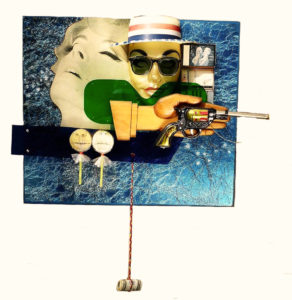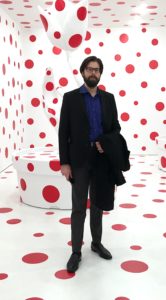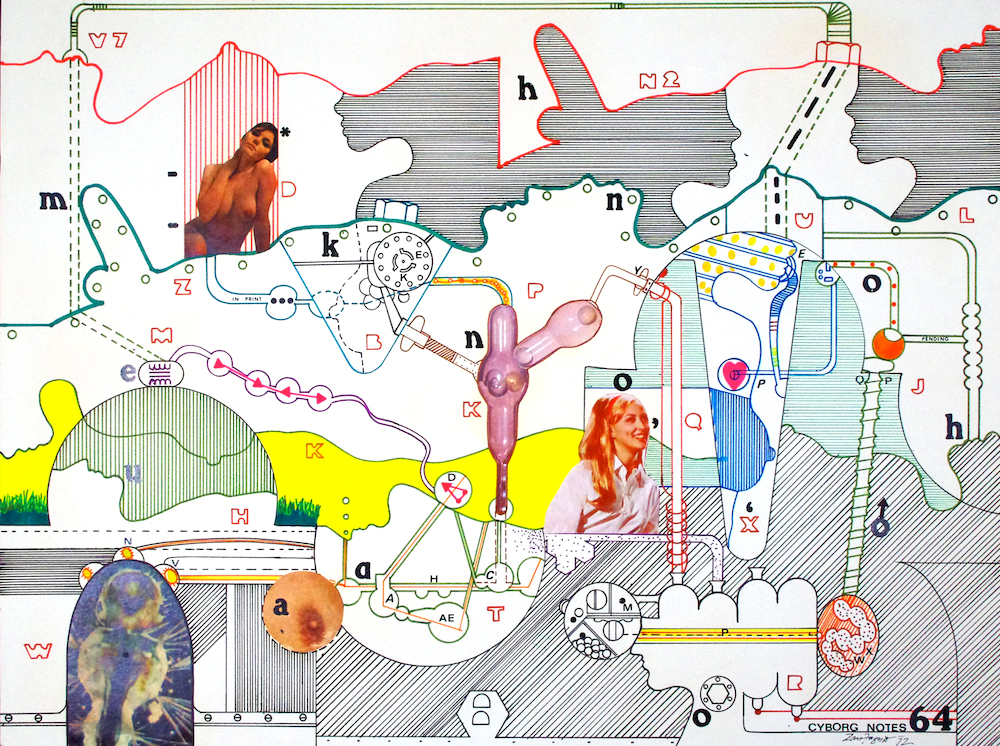It’s Time to Stick Together:

60 years of Collage in America
curated by Peter Hastings Falk
As Editor and Chief Curator of Discoveries in American Art I’m proud to announce the new virtual exhibition, It’s Time to Stick Together: 60 years of Collage in America. This early news release alerts you to an advance viewing before the opening on Monday, August 10, 2020 at www.robertberrygallery.com.
Robert Berry Gallery is a premier New York City-based art gallery. There is something for everyone in this extraordinary collection of colorful, unique and thought-provoking collages by diverse American artists. Collage is a medium that has always tended to defy being pigeon-holed, because its creative process encourages a greater amount of experimentation in construction than does the fear of a blank white canvas. Abstract Expressionism is a seminal force that drives many of these images, but so is Figurative Expressionism, Pop, Surrealism, Outsider, and recent developments in Contemporary expression. Clippings from magazines have traditionally been the most common elements of collage, but many other pieces of popular culture have also been utilized in innovative ways — such as fabrics, photographs, newspaper, commercial packaging, and a variety of found objects.
The word “collage” derives from the French word coller, meaning “to glue” or “stick together.” It is a process that invites composition with different materials and textures in contrast to the consistent fluidity of paint out of the tube. Collage also calls to mind the vibrant works by Cubist painters Picasso and Braque in the early 20th century, where the two artists added new elements—such as wood-grain wallpaper, sheet music, and snippets of faces and bodies—to one picture. The result was a unique pastiche of color, texture and meaning. Collage is one of the most underrepresented genres in the art market today.
The artists featured in this show have incredibly layered and rich stories. Discover the compelling back stories of these artists, most of whom express their motivations in their own words. This exhibition offers unique works by distinguished artists you won’t find anywhere else.
Discover innovative works by:
- Erika Ranee, whose approach to abstract expressionism has been prompted by her research of postcards from the 1920–40s that show the most egregious images of black stereotypes. Her works, like others in this exhibition, may appear to be paintings but are generously layered with cut and torn paper or fabric.
- Ed Welch was an Outsider — a sign painter in Harlem who created a large series of collage portraits that celebrated historically significant black Americans from all professions. His portraits-as-signs engage in compelling social commentary.
- Suzanne Benton has been highly regarded as a dedicated feminist activist since joining the inner circle of the National Organization for Women when it was founded in 1966. She has enjoyed more than 175 solo exhibitions as well as 2 retrospectives.
- Don ZanFagna might be the most famous visionary artist you never heard of. Buckminster Fuller admired him as “a great visionary, artist, and architect.” He was 60 years ahead of his time in predicting the impact of technology on the environment.
- Tom McNease was a true Outsider who lived in the bayous of the most southeastern region of Louisiana for 45 years.Important in the history of collage, he invented a unique transfer technique with acrylic pigments, later called “skins.”

Leo Jensen. Sighs on the Midway, 1965, unique mixed media collage (photomontage and mixed objects on wood), 27 x 29 x 7 inches - Leo Jensen is the only American artist who actually grew up in the circus as a performer. He became a pioneer in Pop Art in the early 1960s and was the first to create kinetic Pop sculpture.
- Sophie Aston’s surreal and paradoxical picture space is clipped from copies of vintage Better Homes and Gardens from the 1950s-60s.
- In the early 1960s Ad Reinhardt named Beverly Brodsky his best student.
- Reva Freedman was a child prodigy violinist who, after a career in the Toronto Symphony Orchestra became a self-taught artist. Her complex layered collages evoke the animistic spirit and mythology inherent in the art of non-literate cultures.
- Walk into any drugstore and you’ll recognize the numerous commercial packaging designs of Harry Bertschmann that have become iconic in American culture — but in his double life for more than 60 years he was also pushing the boundaries of abstract expressionist painting.
- The irreverent Geoffrey Moss also led a double life — as a Pulitzer Prize nominee for his political cartoons by day and an abstract painter by night.
- Reid Stowe’s large collages are the works of a shaman. They are partly composed of sails torn from sailing around the world for 3 years without ever touching earth, or resupplying, or even seeing a human being.
- Gaby Collins-Fernandez emerging talent who embraces collage as a syntactical organization of different languages. As her works break out of the restrictions of the picture frame they are like an emotional surprise and a moment of an embrace.

Ed Welch. Janet Jackson, 2006, mixed media collage on Masonite, 23.5 x 29.5 inches (in the artist’s frame) - As Kokoschka’s only true protégé, Wayne Ensrud’s rhythmical pulsing colors celebrate life.Since the 1970s Paul Forte’s work has explored the subjective and aesthetic dimensions of conceptual approaches to art making through a variety of media that would later become the basis for what the he calls a cognitive approach to art making.
- Bud Holman’s collages from 1959–64 are inspired by the landscape of the Sagaponack dunes on Long Island.
- Rex Ashlock was a Figurative Expressionist who taught in the Bay Area before settling in New York from 1957–80 but chose the relative seclusion and the comfort of whiskey, living what he called “a lifestyle of extreme independence to its fullest.”
- Eugene Healy’s Coastal Weather series convinces us of atmospheric conditions by arranging a variety of disparate materials, including fragments of oils on canvas and printed fabrics, pieces of watercolors on paper, and even pieces of window screens.
- Patrick McElnea’s huge collage is an adaptation of Phil Spector’s ‘Wall of Sound’ methodology and indexes many of the interests seen in his videos.
- Since the 1970s Paul Forte has explored the subjective and aesthetic dimensions of conceptual approaches to art making through a variety of media that would later become the basis for what he calls a cognitive approach to art making.
- Fuller Potter is an Abstract Expressionist, a close friend of Jackson Pollock (until a brawl), who became obsessed with in the unseen energies of the universe.
- Taney Roniger’s Microscapes are fragments of graphite drawings scanned and printed with piezography inks.
- William O. Fredericksen was among the last students of Moholy-Nagy at the Chicago Bauhaus.
Why Robert Berry?
 I was honored by Robert’s invitation to curate an exhibition for his gallery. He has long been a very active member of our Curatorial Board, and for 20 years has applied his expertise in identifying ground-breaking art that provokes the emotions of the viewer. With an eye toward positively influencing our society and contributing to our cultural heritage, he continues to work collaboratively with some of the most innovative emerging 21st century artists. In 2020 he migrated his exhibitions from pop-up project spaces to virtual. International in his reach, he has brought to the fore significant artists across every medium: painting, sculpture, photography, mixed media, digital art, sound art, and video art. Robert advises art industry professionals, galleries, museums, and collectors as they build significant collections that are both meaningful and hold long-term value. Known for his attentive service, Robert even helps to virtually hang his clients’ works so that they can see how they will look en situ. For more information, please visit www.robertberrygallery.com.
I was honored by Robert’s invitation to curate an exhibition for his gallery. He has long been a very active member of our Curatorial Board, and for 20 years has applied his expertise in identifying ground-breaking art that provokes the emotions of the viewer. With an eye toward positively influencing our society and contributing to our cultural heritage, he continues to work collaboratively with some of the most innovative emerging 21st century artists. In 2020 he migrated his exhibitions from pop-up project spaces to virtual. International in his reach, he has brought to the fore significant artists across every medium: painting, sculpture, photography, mixed media, digital art, sound art, and video art. Robert advises art industry professionals, galleries, museums, and collectors as they build significant collections that are both meaningful and hold long-term value. Known for his attentive service, Robert even helps to virtually hang his clients’ works so that they can see how they will look en situ. For more information, please visit www.robertberrygallery.com.
— Peter Hastings Falk

